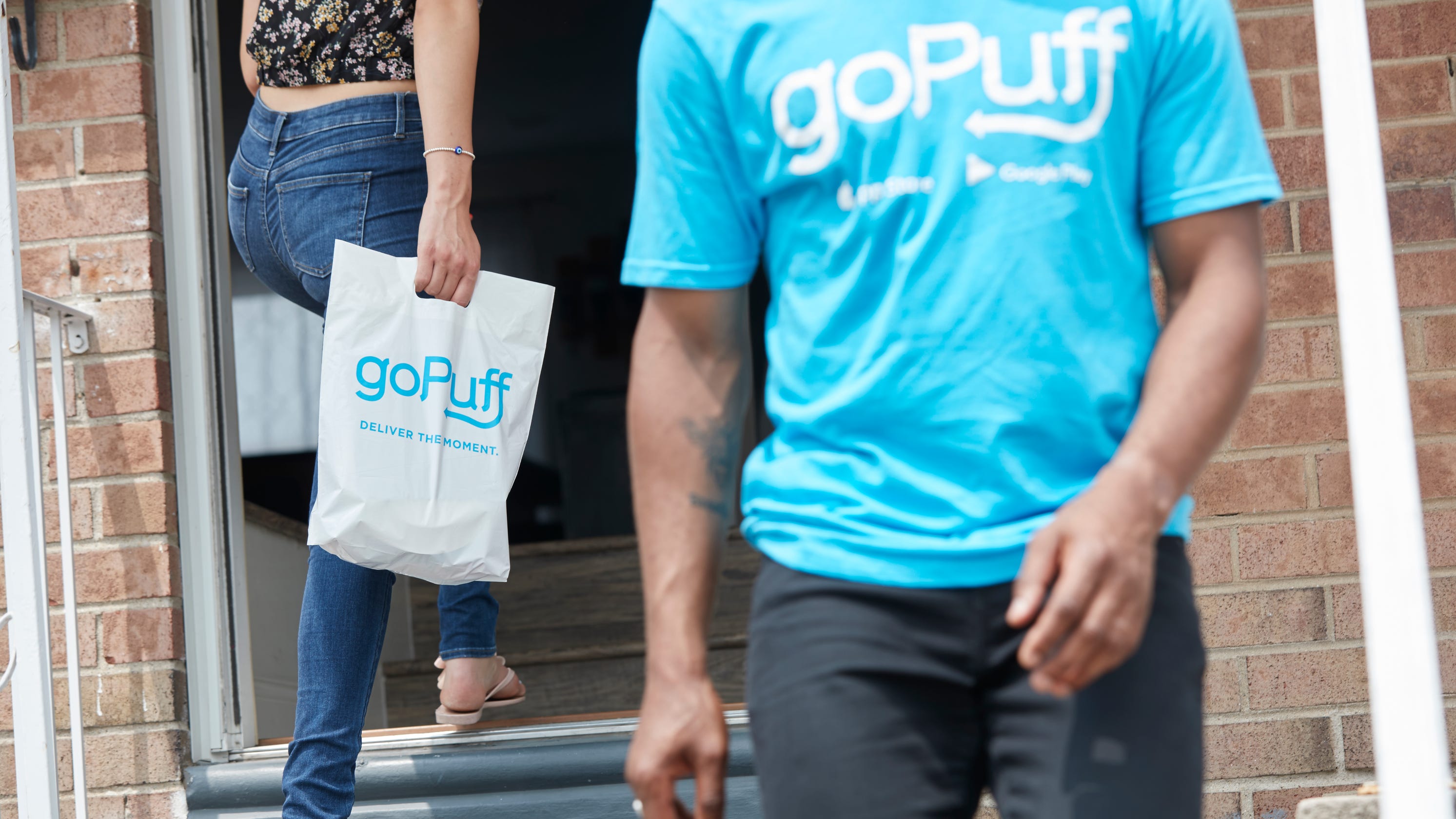

The U.S. convenience store industry is huge, with more than 154,000 convenience stores nationwide serving 165 million daily customers. So when two college students set out to disrupt this retail model, the odds were against them. But as the name goPuff started to pop up everywhere from billboards to social media to word of mouth, it piqued everyone’s interest, including ours.
We conducted a deep dive into this interesting startup: how it works, what makes it so unique, and why you should care.
Contents:
- What is goPuff?
- How does goPuff work?
- Where does goPuff operate?
- Who uses goPuff?
- What does goPuff sell?
- How much does goPuff cost?
- Who does goPuff compete with?
- How is goPuff different and revolutionary?
- Why should brands care about goPuff?
- What can brands do to optimize for goPuff?
What is goPuff?
goPuff is the go-to, on-demand digital delivery service for immediate, everyday needs, from cleaning supplies, household goods and over-the-counter medications to food and drinks, delivered directly to you. In 2013, its co-founders, Yakir Gola and Rafael Ilishayev, were students at Drexel University when they came up with the idea. They realized that going to the store to get supplies, for something like a party or movie night, took too much time that could be spent more productively. So they began to think of ways they could make this process faster and more efficient, creating goPuff along the way. Now, the company is headquartered out of Philadelphia, with smaller, satellite offices located in other major cities.
goPuff continues to grow, with its latest funding round closing in October 2020. According to Crunchbase, goPuff has raised $1.2 billion over 7 rounds, with the latest round being led by existing investor Accel.
How does goPuff work?
Shoppers can order from goPuff through its website or mobile app for iOS and Android. After entering their delivery location, the customer is directed to the inventory and selection available from their local goPuff warehouse. They can then add items to their cart and pay online, similar to traditional digital order platforms.
Once an order is placed, warehouse workers are notified, pick the items from the warehouse shelves, and bag them. Bags are then held in bins specific to each driver, often grouping multiple deliveries to locations in close proximity when possible. Drivers then collect the bags from their bin and head out to complete the deliveries.
Shoppers are notified of each step in the delivery via playful, often customized text messages, and then called by the driver upon arrival. Since their vertically integrated delivery model cuts out the middleman, goPuff is able to deliver orders to customers as soon as they are received, usually taking around 15-30 minutes. goPuff is open around the clock, 24/7 in most locations; some smaller markets have working hours from noon to 4:30 am.
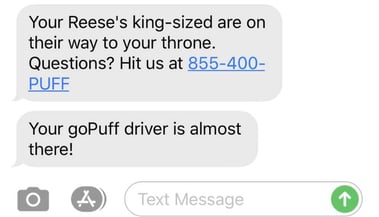
goPuff is open around the clock, 24/7 in most locations; some smaller markets have working hours from noon to 4:30 am.
Where does goPuff operate?
goPuff is currently available in over 200 U.S. locations. Mainly operating in major cities, the service started targeting college students but has expanded its offering to appeal to young professionals and parents within a 30-minute drive radius. The company’s website even suggests that their followers should tweet at goPuff to make requests of where to begin delivering next, and that they will likely start evaluating the places where they receive the most support.
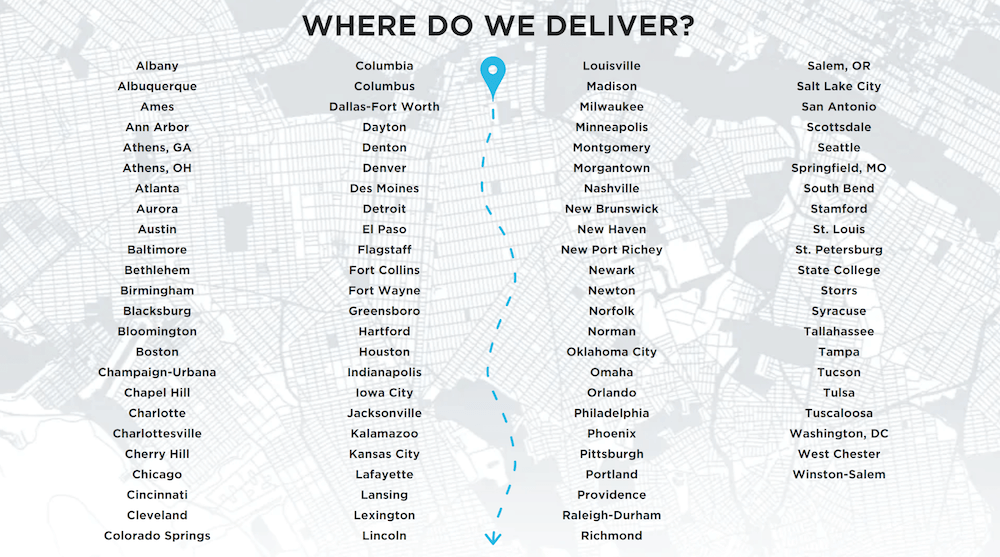
When launching a new location for expansion, the company’s representatives first look for large, reasonably priced warehouse space to run its operation. Once the warehouse location is secured, they begin to hire local, independent delivery drivers and cultivate relationships with regional suppliers and local brands.
Who uses goPuff?
goPuff, which started on a college campus, took the idea of marketing towards a younger audience and ran with it. This has proven to be a strong tactic for a company that wants to displace the convenience store industry, as a report by Technomic suggests that 51% of convenience store shoppers are millennials.
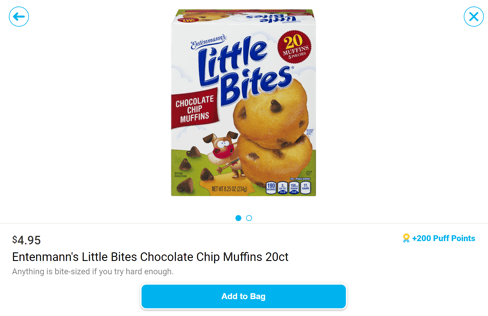
The average goPuff shopper is in their mid to late 20’s, but has expanded from targeting only students to including busy, career-focused individuals and parents. But regardless of the demographic, the platform is known to focus on creating a more personal connection between the brand and its audience. For this reason, goPuff is known for creating viral marketing campaigns like humorous product descriptions, pun-ny text notifications, eye-catching social media video content, bright public transportation advertisements and free branded swag included in first-time orders. Most shoppers tend to be repeat customers and engage with the brand through other channels, like Twitter and Instagram.
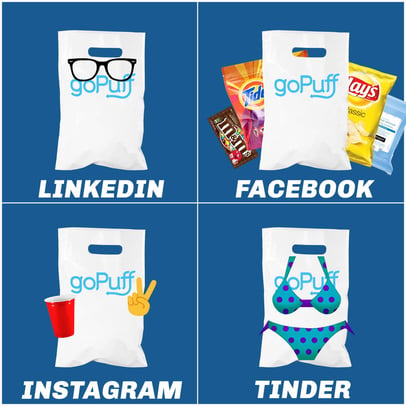
Not only this, but the co-founders have placed a strong emphasis on understanding their shoppers. Part of their marketing process is figuring out where customers are ordering from (i.e., dorm rooms, offices, libraries, parks), what time they are ordering, and what types of products they are ordering most so that they can adjust their tactics accordingly. While the company has no plans of selling their data at this time, it does have immense proprietary value.
What does goPuff sell?
From groceries and cleaning supplies to personal care items,snacks and, in select markets, alcohol — goPuff offers goods that are typically found in a c-store. Most goPuff locations have more than 3,000 products, sourced from more than 40 local and national suppliers, to choose from. Some of the service’s overall bestsellers include ice cream, seltzer, bags of chips, Plan B (morning-after pill) and plastic cups. This is because goPuff focuses on a few specific shopping occasions:
- In-the-moment desires: These are items that are wants, not needs, aimed at providing instant gratification, like food cravings and late-night snacking. Some of the featured categories on the website that facilitate these desires include Cocktails and Snacks.
- Sudden essentials: These are items that don’t make sense to wait for an Amazon Prime 2-day delivery, such as when something important unexpectedly breaks or runs out. Some of the featured categories include Wardrobe Malfunction, Overnight Travel Needs and Feel Better Fast. Example products include deodorant, over-the-counter medicine, party supplies, a phone charger and diapers.
- Embarrassing purchases: These are items that could help save face (i.e., with a somewhat awkward or negative stigma) when checking out in person. Examples include the morning-after pill, condoms, feminine care products and antacids.

In some markets, goPuff also sells and delivers beer and alcohol, known as goBooze. However, these items come with a stricter identity confirmation policy and a 50% restocking fee if the shopper is underage.
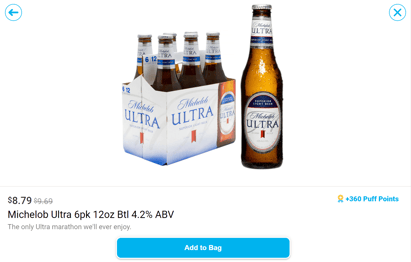
The buyers at goPuff use the platform RangeMe to source new products for their service. (RangeMe is an application that is used by suppliers and buyers to help manage proposals, showcase items and build relationships.)
Brands that wish to sell on goPuff can do so by listing their products on RangeMe. Supplier profiles are free to make and allow brands to tailor product and company descriptions in a digital portfolio. Buyers are then recommended products that might be relevant to their market or are able to search and engage with brands directly.
The goPuff website also has a brand partnerships contact page for inquiries about sampling with the service.
How much does goPuff cost?
In addition to being convenient, goPuff is also competitively priced. goPuff charges a $1.95 flat delivery fee. Recently the company started charging a $2.95 incremental fee if there’s alcohol in a customer’s cart. There is a minimum order amount of $10.
Frequent goPuff shoppers can opt to purchase a membership to become part of the “Fam.” The membership costs $5.95 per month and includes free delivery on every order.
Unlike other mobile delivery services, goPuff does not rely on delivery fees to make a profit. Because of this, delivery prices never surge based on times of high demand. In contrast, most of goPuff’s competitors have delivery fees around $5, which can vary based on volume and time of day.
Who does goPuff compete with?
While goPuff does somewhat overlap with other on-demand delivery apps, such as Instacart, Uber Eats and Postmates, its biggest competitors are stores with strong “convenience” offerings. Retailers likely feeling the pressure from this type of service include 7/11, Cumberland Farms, CVS, Walgreens and Wawa. The goal behind creating an offering like goPuff in the first place was to make daily life easier and physical convenience stores more obsolete.
How is goPuff different and revolutionary?
goPuff is unique within the delivery service space as it has become the first and only offering to cut out the middleman, making it a literal “one-stop” shop. The supply chain factors that help contribute to this are:
- Personally owned warehouses: Rather than acting as a service that picks up items from partner businesses, goPuff owns local facilities to house available inventory in the cities it services. Orders simply go directly from the warehouse to the customer, cutting down on the logistics involved.
- Upfront inventory: Because goPuff owns physical distribution centers, it buys product inventory in bulk at wholesale price from suppliers. This keeps prices low and eliminates the need to rely on delivery fees for profit. The company also has developed a predictive algorithm that allows each location to stay on top of stock levels, reducing the risk of out of stocks and the need to substitute products.
- Contract drivers: goPuff does not hire third-party courier services or middlemen to transport orders. Instead, they contract individuals with their own vehicles to act as gig workers in their free time. This approach not only speeds delivery times, but also eliminates the company’s cost for fuel. In addition, while goPuff shoppers have the option to tip for deliveries, a driver’s paycheck does not depend on it. Drivers are paid based on order volume and tend to make an average of $10-$12 an hour.
This combination of factors results in a truly convenient and quick offering. Bottom line is that goPuff can sell the same products as their competitors and deliver it straight to the customer’s door, with even lower overhead costs.
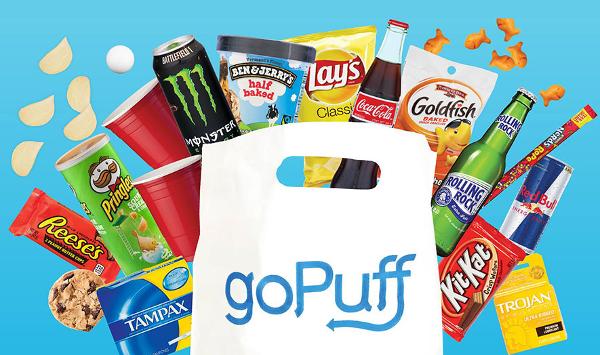
Why should brands care about goPuff?
There are quite a few reasons why brands should be taking goPuff seriously:
- goPuff is redefining impulse shopping
One area that eCommerce has not been able to capitalize on completely is instant gratification. It is inconvenient for consumers to wait over an hour to satisfy an ice cream craving or when they run out of beer at a party. But this is where goPuff excels and has set out to reinvent the process. The company understands that ease of use and convenience are critical elements in persuading shoppers to make these kinds of spur-of-the-moment transactions online.
Additionally, this type of service is asking consumers the question: how important is convenience in terms of brand preference? The role of the brand name might become less prominent as shoppers check which options can be delivered prior to choosing a brand, instead of the other way around.
- goPuff is capturing the attention of millennials and Gen Z
Not only does goPuff target a younger audience, but they successfully reach it. With the combination of edgy marketing materials, strategic service locations and affordable prices, telling someone to “goPuff it” is becoming more and more common among a collegiate, tech-savvy crowd.
This is the type of attention CPG companies desperately need, and that goPuff can offer. Virtual shelf space, product categorization and targeted marketing campaigns are set up to help their brand partners become relevant and win in the millennial market.
- goPuff does not overlap with Amazon
In the world of eCommerce, there is tremendous emphasis placed on brands to play on Amazon or be left behind. But in contrast, goPuff provides a better solution for a consumer’s immediate needs than Amazon does. Think situations like running out of toilet paper, needing cough medicine for a sudden sickness, or craving a late-night snack — all scenarios where shoppers are still turning to convenience stores, as Amazon’s Prime Now approach is not as ideal.
So, while Amazon presents a problem for larger retailers like Walmart and Target, convenience stores have not seen a dramatic effect. This means that goPuff is not in direct competition with Amazon, which is rare and noteworthy.Service # of markets Delivery fees Additional fees Minimum order value Average delivery speed # of products per market goPuff ~150 $1.95 per order or free with a Fam subscription of $5.95/month (which totals ~$72/year) Optional tip for delivery drivers $10 30 minutes ~3,000 Amazon Prime Now ~100 Free with an Amazon Prime subscription of $119/year $8 for one hour delivery, $5 for orders under the minimum value, optional tip for drivers $35 2 hours ~10,000 - goPuff will only continue to grow
goPuff made headlines with its most recent round of funding in October 2020. And while the company does not publicly release sales data by market, it has made it known that all operating locations are currently profitable, with even more locations in the works.
Additionally, both the company and its co-founders continue to be recognized for their business achievements, including receiving the title of “2017’s Target Marketer of the Year” and being highlighted in “Forbes’ 30 under 30: Retail and eCommerce” list. In July 2020, goPuff was named to the 2020 CNBC Disruptor 50, an annual list of ambitious and innovative private companies disrupting technology and changing the industry. Seems little sign of slowing them down in the near future.
What can brands do to optimize for goPuff?
The key for brands to take advantage of goPuff is to get noticed and stay relevant. Since goPuff is a limited selection retailer, the #1 hurdle is to be chosen for distribution, and not get rotated out. In order to be accepted into goPuff’s assortment, brands should focus on a few factors:
- Demonstrate the built-in demand for products by highlighting search volume, branded keywords and sales in other channels.
- Showcase products with sustained high growth rates or accelerating momentum. This is especially important for categories that goPuff is trying to test, expand into or increase representation for.
- Offer products with price pack architectures that support sustainable unit economics and reliably deliver high margins.
- Prove the value of products that complement current offerings to help increase average order size or facilitate repeat purchases.
Once chosen as a supplier, brands should turn their focus to:
- Staying in-stock. Since goPuff uses an algorithm to detect when inventory needs to be restocked — which is not on a regular cadence but instead demand-based — meeting demand right when it happens is crucial. In general, stock outages hurt both retailers and brands, but for a high-velocity, limited assortment player like goPuff, the stakes of staying in-stock are even higher.
- Helping improve product content. The current structure of the platform is a bit scarce when it comes to visual content, supplemental product information, or shopper ratings and reviews. So supporting goPuff in providing shoppers with better product content is a natural way to move beyond the basics, like staying reliably available on-shelf.
Want more insights on retailers like goPuff? Sign up for our Digital Shelf Digest Newsletter!


























